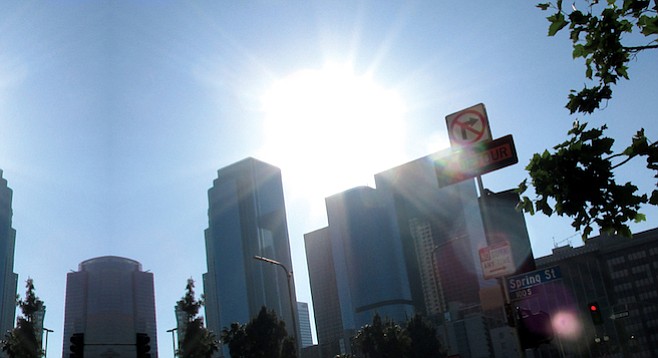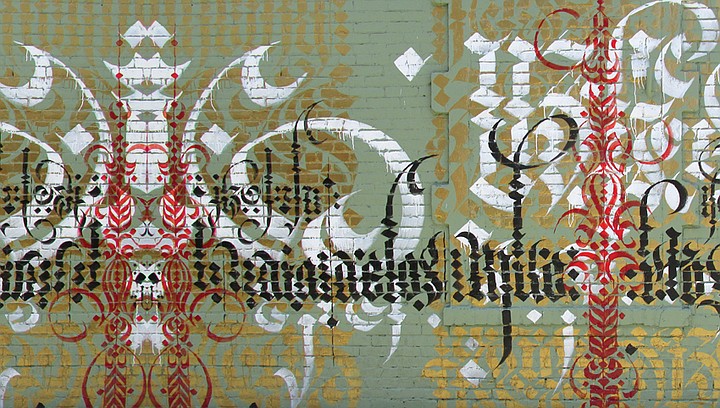 Facebook
Facebook
 X
X
 Instagram
Instagram
 TikTok
TikTok
 Youtube
Youtube

In the 90s and early 00s, despite its impressively tall high-rise skyline, downtown Los Angeles was generally NOT somewhere you would go by choice. Maybe once in awhile for a museum or a convention. Or maybe for work… but then you'd get the hell out, especially before it got dark. At street level, it was rather desolate and at times quite dangerous.
But now? Years later, it's a whole different story.
These days, it’s actually worth it to make the trip downtown — and it can be done without a car, with various metro lines and bus lines consolidating there. Most of which are new, modern and efficient.
Downtown's roughly defined by the 110 freeway to the west, 10 to the south, L.A. River to the east, and 101 freeway forming the northern border... although downtown IS expanding beyond this perimeter (especially since most of the freeways are elevated).
In the eastern section by the L.A. River, out of nowhere, the incredible Arts District popped up over the past few years. Seemingly overnight, old warehouses have been converted into trendy bars, cafes, restaurants, shops, galleries and studios. This Arts District has several "centers," so feel free to wander from 1st St. all the way down to 8th — and take in the various murals and street art while you’re at it.
Little Tokyo is adjacent and, needless to say, it offers solid dining options. As a starting point for both of these areas, there's the Little Tokyo/Arts District metro station on the Gold Line.
The northern section of downtown has Grand Park, a nicely maintained public space to hang out in that also offers live music and other outdoor events. In the vicinity are lots of museums and places of cultural interest, like the recently inaugurated Broad Museum and the architecturally impressive Disney Hall. Among the various civic buildings is City Hall - located nearby and with free access to their top-floor observation deck.
This area is accessible via the Civic Center / Grand Park Metro station on the Red and Purple Lines.
The western section of downtown includes the Spring Street area, which houses another art-centric district, which hosts an evening Art Walk event and party on the second Thursday of each month (highly recommended). There are also plenty of shops here — one of which is the incredible The Last Bookstore on W. 5th St. The public spaces here have also been revitalized, such as Pershing Square.
Nearby is the famous Grand Central Market for all kinds of international eating options. And continuing west is the financial district and lots more landmark buildings. The Pershing Square Metro station on the Red and Purple Lines is a good starting point here.

In the southern part of downtown is Santee Alley, with lively street markets offering all types of clothing and other goods in a lively atmosphere. The vibe here is mostly Latino. The adjacent Fashion District is the place for aspiring fashion designers to acquire wholesale products.
Tucked in the southwestern corner of downtown is the Staples Center for L.A.'s NBA teams, the Convention Center and Microsoft Theater. This area can be accessed via the Pico Metro station on the Blue and Expo Lines. (Santee Alley will be a bit of a walk east of here, but is worth it.)
At night, there's a decent amount of activity. Some notable spots are The Exchange for electronica/club events; the historical Mayan Theater and Orpheum Theater, among plenty of other live music venues; and The Standard with its famous rooftop bar.
For more bars, there are lots of trendy rooftop bars — but also low-key spots like the historic La Cita and several craft beer places in the Arts District. But all around downtown, new bars are cropping up everywhere, catering to different styles and budgets.
The only area to really avoid is the notorious Skid Row, located smack bang in the middle of downtown, concentrated around the (ironically named) Wall St, San Julian St and San Pedro St — roughly between 5th St. and 7th St., and a complete contrast to the cosmopolitan downtown as described above. But this area (consisting of just a few blocks), is more depressing than actually dangerous.
If you still have time, there are some neighboring districts just outside of downtown: Chinatown (kind of its own area, but steps away from downtown) to the northwest but also accessible on the metro Gold Line. And the up-and-coming ("gentrifying") Latino neighborhood of Boyle Heights just across the L.A. River to the east, accessible also via the Gold Line (plus a little walking or bus required).
From San Diego, the most efficient and most beautiful way is via the Pacific Surfliner inter-city train, from America Plaza along the spectacular San Diego County coastline, past Orange County suburbia, L.A. County’s industrial core (impressive in its own way, with lots of graffiti artwork and urban panoramas and views of the downtown skyline), and finally downtown Los Angeles’ impressive Union Station, which connects directly to the Metro Gold Line...
So yeah, an easy day-trip or weekend trip. Get your fix of culture, art and shopping!


In the 90s and early 00s, despite its impressively tall high-rise skyline, downtown Los Angeles was generally NOT somewhere you would go by choice. Maybe once in awhile for a museum or a convention. Or maybe for work… but then you'd get the hell out, especially before it got dark. At street level, it was rather desolate and at times quite dangerous.
But now? Years later, it's a whole different story.
These days, it’s actually worth it to make the trip downtown — and it can be done without a car, with various metro lines and bus lines consolidating there. Most of which are new, modern and efficient.
Downtown's roughly defined by the 110 freeway to the west, 10 to the south, L.A. River to the east, and 101 freeway forming the northern border... although downtown IS expanding beyond this perimeter (especially since most of the freeways are elevated).
In the eastern section by the L.A. River, out of nowhere, the incredible Arts District popped up over the past few years. Seemingly overnight, old warehouses have been converted into trendy bars, cafes, restaurants, shops, galleries and studios. This Arts District has several "centers," so feel free to wander from 1st St. all the way down to 8th — and take in the various murals and street art while you’re at it.
Little Tokyo is adjacent and, needless to say, it offers solid dining options. As a starting point for both of these areas, there's the Little Tokyo/Arts District metro station on the Gold Line.
The northern section of downtown has Grand Park, a nicely maintained public space to hang out in that also offers live music and other outdoor events. In the vicinity are lots of museums and places of cultural interest, like the recently inaugurated Broad Museum and the architecturally impressive Disney Hall. Among the various civic buildings is City Hall - located nearby and with free access to their top-floor observation deck.
This area is accessible via the Civic Center / Grand Park Metro station on the Red and Purple Lines.
The western section of downtown includes the Spring Street area, which houses another art-centric district, which hosts an evening Art Walk event and party on the second Thursday of each month (highly recommended). There are also plenty of shops here — one of which is the incredible The Last Bookstore on W. 5th St. The public spaces here have also been revitalized, such as Pershing Square.
Nearby is the famous Grand Central Market for all kinds of international eating options. And continuing west is the financial district and lots more landmark buildings. The Pershing Square Metro station on the Red and Purple Lines is a good starting point here.

In the southern part of downtown is Santee Alley, with lively street markets offering all types of clothing and other goods in a lively atmosphere. The vibe here is mostly Latino. The adjacent Fashion District is the place for aspiring fashion designers to acquire wholesale products.
Tucked in the southwestern corner of downtown is the Staples Center for L.A.'s NBA teams, the Convention Center and Microsoft Theater. This area can be accessed via the Pico Metro station on the Blue and Expo Lines. (Santee Alley will be a bit of a walk east of here, but is worth it.)
At night, there's a decent amount of activity. Some notable spots are The Exchange for electronica/club events; the historical Mayan Theater and Orpheum Theater, among plenty of other live music venues; and The Standard with its famous rooftop bar.
For more bars, there are lots of trendy rooftop bars — but also low-key spots like the historic La Cita and several craft beer places in the Arts District. But all around downtown, new bars are cropping up everywhere, catering to different styles and budgets.
The only area to really avoid is the notorious Skid Row, located smack bang in the middle of downtown, concentrated around the (ironically named) Wall St, San Julian St and San Pedro St — roughly between 5th St. and 7th St., and a complete contrast to the cosmopolitan downtown as described above. But this area (consisting of just a few blocks), is more depressing than actually dangerous.
If you still have time, there are some neighboring districts just outside of downtown: Chinatown (kind of its own area, but steps away from downtown) to the northwest but also accessible on the metro Gold Line. And the up-and-coming ("gentrifying") Latino neighborhood of Boyle Heights just across the L.A. River to the east, accessible also via the Gold Line (plus a little walking or bus required).
From San Diego, the most efficient and most beautiful way is via the Pacific Surfliner inter-city train, from America Plaza along the spectacular San Diego County coastline, past Orange County suburbia, L.A. County’s industrial core (impressive in its own way, with lots of graffiti artwork and urban panoramas and views of the downtown skyline), and finally downtown Los Angeles’ impressive Union Station, which connects directly to the Metro Gold Line...
So yeah, an easy day-trip or weekend trip. Get your fix of culture, art and shopping!
Comments